How to Help Save Endangered Hedgehogs

Hedgehogs are one of England’s favourite mammals. These prehistoric spiky creatures have charmed people for generations, yet their numbers are falling fast.
And of course as one of England’s three hibernating mammals (along with dormice and bats), they need to find safe places for a winter sleep.
The good news? Ordinary people can make a big difference. Here are practical steps anyone can take to help make the world safer for hedgehogs.
Dogs (like badgers) are natural predators of hedgehogs, so don’t encourage them to go near our spiky friends.
Use Garden Shears (not strimmers)
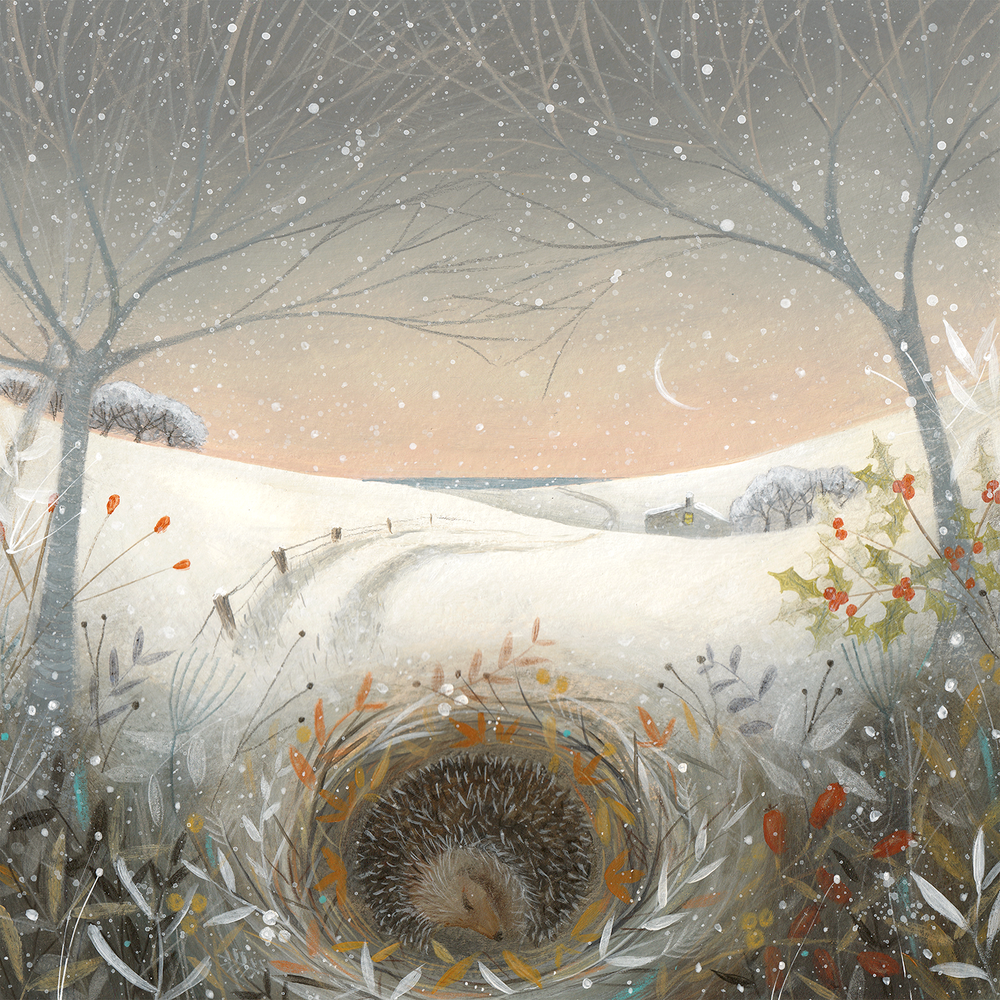
Garden strimmers cause awful injuries to lots of wildlife (from hedgehogs to frogs). Use garden shears (good exercise too!) instead. Manual mowers are also safer (avoid robotic mowers, as sleeping hedgehogs cannot move fast enough, before being struck).
If you do use use conventional lawnmowers and strimmers, then check long grass (and compost heaps and piles of leaves) beforehand. Lift the grass gently with a stick or your foot, to alert hidden hedgehogs, giving them chance to escape.
Avoid Using Slug Pellets
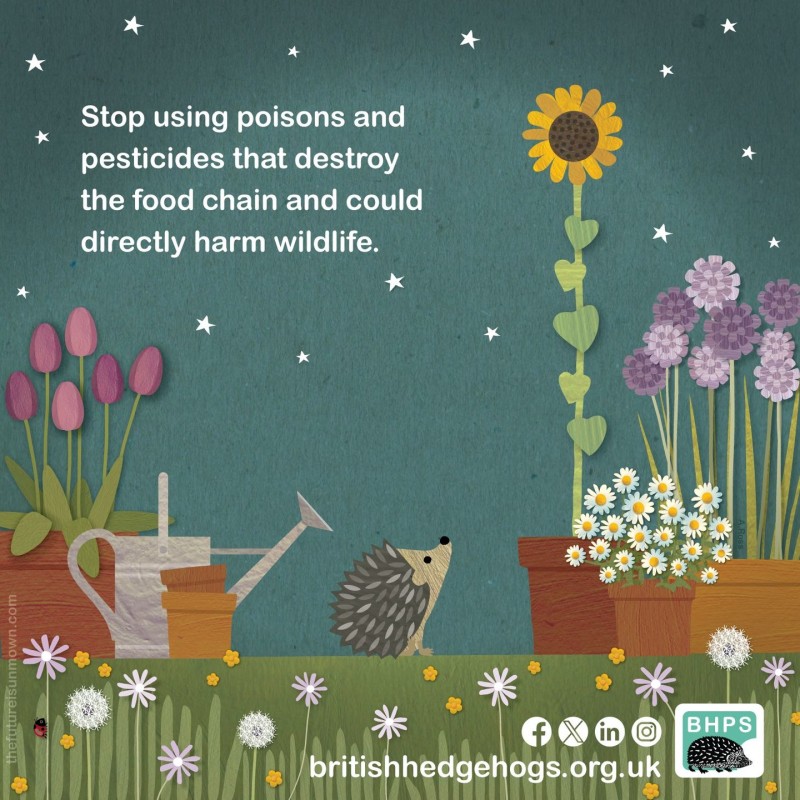
Slug and snail pellets are lethal to all wildlife (and pets, despite some being labelled ‘pet-friendly’). These slimy creatures form an important part of the ecosystem, providing natural food for birds and wildlife. If you use slug pellets, you usually kill all the wildlife that eat them too.
Gardening organically will encourage hedgehogs, birds and frogs to your garden, to eat slugs and snails for you, as part of nature’s food chain. Or choose nontoxic humane slug and snail deterrents.
Don’t let dogs eat slugs or snails, it can cause lungworm, which is a medical emergency. Read more on pet-friendly gardens.
Other Hedgehog Garden Hazards to Avoid
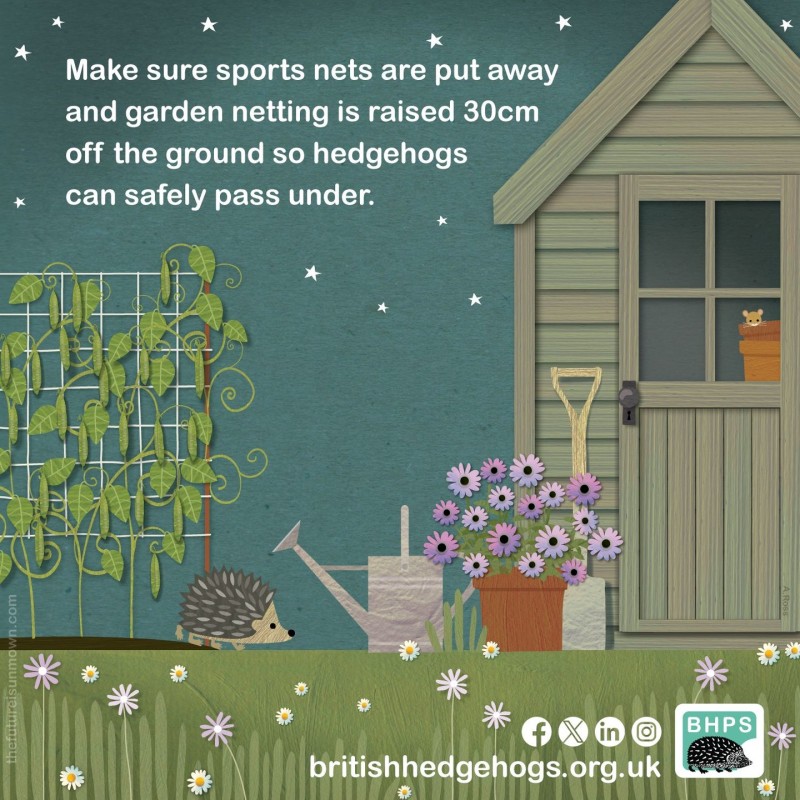
Hedgehogs are very curious creatures, so always remove garden litter. Common hazards are:
- Plastic bags
- Empty plant pots
- Broken glass
- Barbed wire
- Oil & paint
Street litter is also hazardous, including drink can rings and rubber bands (cut both up and bin, if you see any). There are campaigns to ask Royal Mail to swap these for paper belly bands, the rubber bands are also fed to chicks by ducks, which think they are worms).
If painting fences, sheds or garden furniture, use nontoxic wood stain. Creosote is now banned for sale (for domestic use), but many fence stains contain dangerous chemicals.
Always put away rotary clothes lines, when not in use. Also avoid netting in gardens.
Football nets are a hazard for hedgehogs to foxes. If you use one, ensure it’s put away safely at end of use. A better idea is this Goal Wall (made from recycled milk bottles!) This company makes lots of garden goodies made from recycled plastic.
We don’t recommend the bird house, as plastic could over-heat – use untreated wood instead. Read our post on safe havens for garden birds for more info).
Cover Drains and Exposed Holes
Hedgehogs often fall into uncovered drains (especially small waste traps outside kitchens) or manholes. Cover open drains with grates, and fill unused holes (check daily during construction projects).
If you find a hedgehog trapped in a drain, Tiggywinkles Wildlife Hospital says the only solution is to pull it out by clamping two pairs of pliers to its spines, and gently lifting.
Take the hedgehog to a wildlife rescue centre if there were chemicals in the drain, to check for burns and injuries. Same for hogs that fall into oil, paint or tar (don’t attempt to clean it off yourself).
Create Hedgehog Highways

In nature, hedgehogs would live in hedges (hence their name). But due to England having lost most of its wild spaces, hedgehogs now need a network of gardens to travel up to 2 miles each night, to find food.
But high fences and solid walls can trap them (so they can never find a mate). Or force them into urban areas (hence why so many hedgehogs are killed on roads).
So until we manage to restore England’s hedgerows (and plant more of them), the best way to help hedgehogs is to create a network of ‘hedgehog highways’. This means creating small gaps (13cm square – the size of a CD) at the bottom of garden fences and gates.
Be sure to check hedgehog highway gaps regularly, to remove debris and overgrown plants. The Wildlife Community’s Hedgehog Crossing is made from recycled plastic, and comes pre-drilled with holes for fixing, and instructions.
This allows hedgehogs to travel from garden to garden, which is the best alternative to living in the wild. As long as the gardens are organic and safe from litter and hazards like slug pellets, it’s the best way we can help them to thrive.
As hedgehogs are nocturnal, you can cover the highways during the day to prevent pets escaping, as hogs will only use them at night.
Provide Hedgehog Homes & Fresh Water
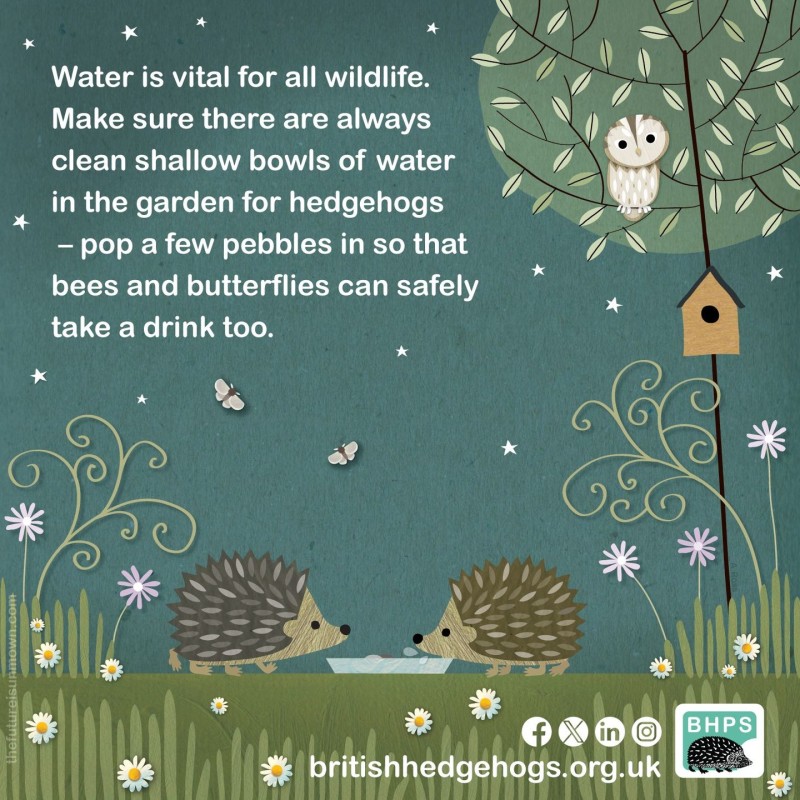
Natural hedges provide shelter for sleeping, nesting and hibernation. But in gardens, it’s important to offer a helping hand.
Hedgehogs also appreciate a shallow bowl of fresh water (add a log platform, so bees and butterflies don’t drown, if they use it).
Hedgehogs thrive when we leave our organic gardens a ‘bit messy’, with leaves and old logs etc, so they can kind of make their own nesting places.
If you buy a hedgehog home, choose a good brand from people who know what they are doing.
These usually have tunnel entrances to protect from predators, sited in quiet spots (away from wind, busy paths and pet food bowls, to keep dogs away).
If you wish, you can place leaves and grass inside to encourage them. Organic gardens will have plentiful ‘free food’ like worms, beetles, caterpillars, earwigs, millipedes and slugs.
Once sited, leave the hedgehog house alone, and only move it to clean (in March or October, between breeding and hibernation seasons).
An easy way to check if a hedgehog house is still in use, is to place a small stick or flower head in the entrance for a few nights (that needs to be pushed aside, to enter or exit).
If you accidentally uncovering a nesting hog, replace the bedding and leave well alone.
To clean an empty hedgehog house, remove old bedding, clean with boiling water, then air-dry completely. Don’t worry about fleas (they are not transferrable to other species). Never use dog/cat flea powder in hedgehog houses (or on hedgehogs).
The Wildlife Community has a good selection of quality hedgehog houses. For rescuers, it recommends wooden hedgehog homes (where roofs can be opened for checking – not ones with open bottoms).
- Hogilo is the choice of British Hedgehog Preservation Society. The swivel lid allows easy cleaning, and there’s an overhanging roof and porch to protect against rain (the raised feet prevents rot). The small entrance tunnel leads to a porch.
- Happy Hog Cafe includes a predator-resistant tunnel. This slots together easily, with hassle-free access for cleaning and maintenance.
- Igloo Hedgehog Home has a small entrance tunnel to protect from pets and badgers (anchor down for extra security). The steel frame has a waterproof rattan roof, spacious enough for a mother and hoglets. With brushwood cover, this can be used for hibernation.
Make Ponds Safe for Hedgehogs
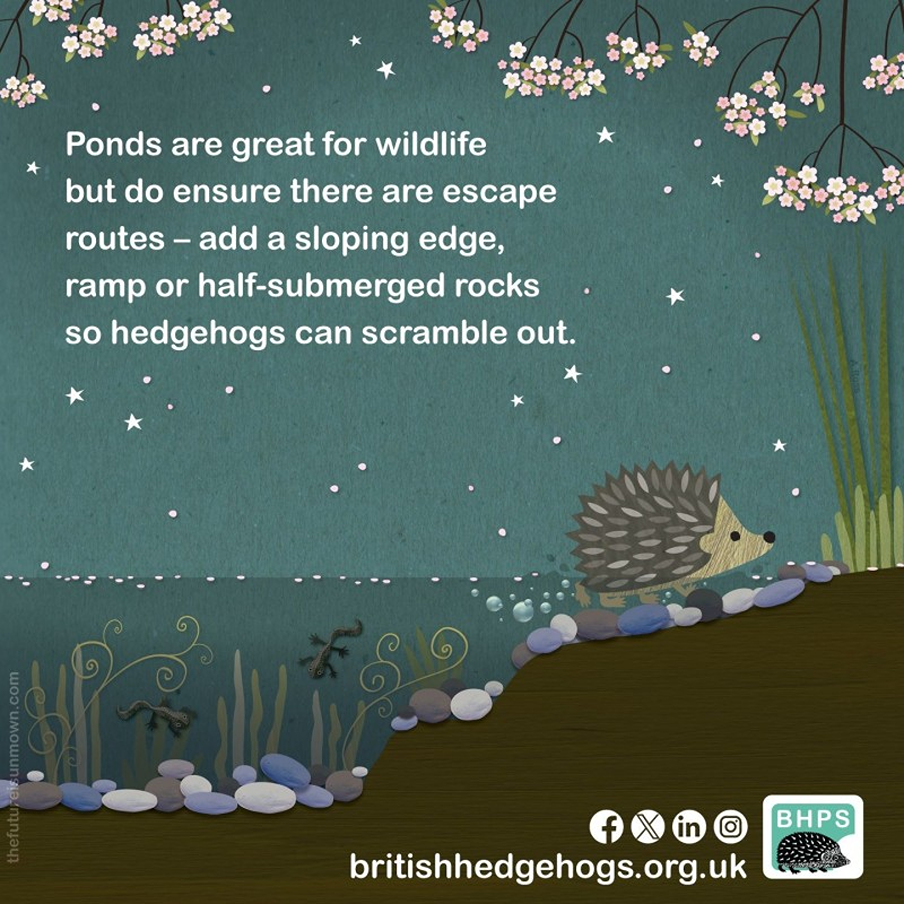
Hedgehogs are good swimmers, but it’s important that garden ponds have sloping sides, for easy exit, should wildlife fall in.
Netting is another hazard, so don’t use this on garden ponds. Read our post on wildlife-friendly ponds on how to humanely deter herons.
Avoid Disturbing Hibernating Hedgehogs

Hedgehogs typically hibernate from November to March (don’t disturb them). They will find places with logs and leaf piles, and particularly like compost heaps.
Don’t fork compost bins (just lift them gently to check for hiding hedgehogs and frogs). If you need to move piles of logs or compost heaps during this time, check first for sleeping hedgehogs.
If planning to knock down a shed or outbuilding, check first for nesting hedgehogs. Lift the floor carefully and do not disturb nests. Postpone work for at least a month, until you are sure that little hedgehogs have left.
Avoid Bonfires
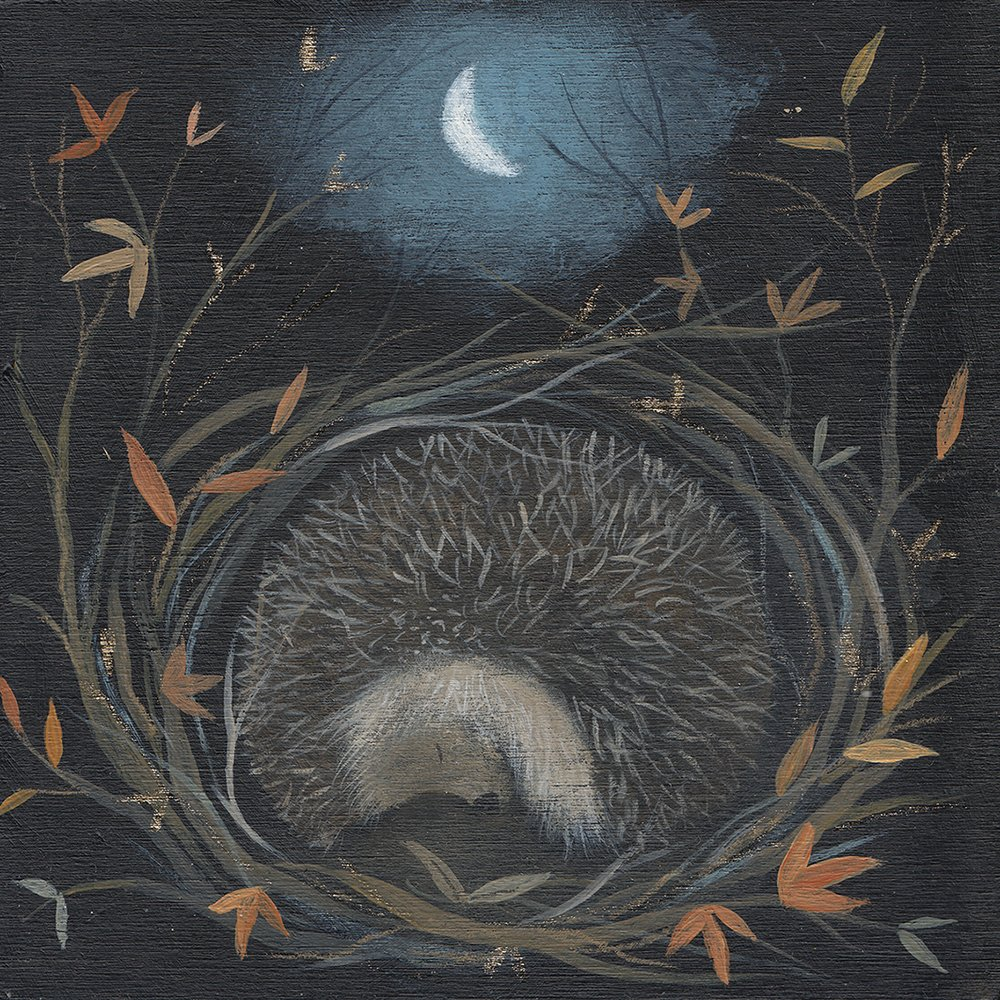
Hedgehogs love crawling into wood piles or bonfires for shelter, especially in autumn. Ideally avoid bonfires. If you do light one, ideally build it just before lighting. Or move the pile just before lighting (a metre or two is enough to give snoozing hedgehogs a chance to escape).
Use a broom handle, rake or torch to gently prod and check inside the pile. If you find a hedgehog, wear gloves (fleas are not transferrable to other creatures but their spikes could tickle) and move the creature to a nearby sheltered spot.
Once you are sure the bonfire is free from hedgehogs, light it from one side only, so any creature in the heap has a chance to escape.
How to Prevent Hedgehog Road Accidents
Each year, many hedgehogs are killed, due to a lack of natural habitats and ‘hedgehog highways’. Providing these are by far the best methods to prevent hedgehogs venturing near roads and urban areas.
- Keep to speed limits.
- Be alert for wildlife, especially at dawn and dusk.
- Use full beam at night (dipped lights are best in fog, rain or snow, or else light could reflect back and startle).
- Keep your lights, brakes and windscreens in good condition.
- Use a car trash bag to avoid dropping litter out the window. This stops scavengers (and animals that scavenge on dead animals).
Councils can help by installing wildlife reflectors that fit along road verges and send car headlights sideways into the undergrowth. This sudden flash can scare wildlife back from the roadside. Reflectors are most useful in places where other options, like tunnels or fencing, aren’t possible or practical.
They’re quick to fit and don’t cost much, making them an easy way to cut accidents while more permanent fixes are planned. It’s best to buy orange-hued ones, rather than blue/white.
Wildlife crossings abound abroad, but in England we only have a few. The science of ‘road ecology’ looks at how to create tunnels and over-passes to help billions of animals migrate and travel, without harm. The cost is far less than cleaning up roadkill.
Help Injured or Orphaned Hedgehogs
Hedgehogs are nocturnal. So if you see one during the day, usually there is something wrong. Use gardening gloves to pick it up, place in a high-sided box with a towel (no tassels), and keep it warm.
- Follow first aid advice here. Never leave out bread and milk for hedgehogs, as these can harm.
- Contact British Hedgehog Conservation Charity (01584 890801) for advice over the phone, they can also direct you to local wildlife rescuers. Handle hedgehogs carefully with gloves, place in a high-sided box with a towel and water bottle for warmth.
Support Hedgehog Conservation Charities

British Hedgehog Preservation Society is our national charity of experts, where you can find information to share, a phone helpline and leaflets for gardeners and farmers.
It has local branch volunteers nationwide who can give advice and practical help. The website provides lots of advice and education.
An easy way to support this wonderful organisation is to buy their envelope reuse stickers, which help to save trees by reusing envelopes. And promotes their charity at the same time, while helping to raise funds through purchase.
Another way to help is to sign up to easyfundraising, and nominate it as your chosen charity. Then anytime you shop with registered companies (shops to services), they give a portion of your sale to help hedgehogs, at no cost to you.
Also support local hedgehog rescue charities. You could also join the Big Hedgehog Map Survey and sign up to the National Hedgehog Monitoring Programme.
Books to Learn More About Hedgehogs

- The Hedgehog Handbook is a guide for anyone with a penchant for prickles! The author explores hedgehog eating and sleeping habits, and how to preserve this icon of rural life.
- A Handful of Happiness is the story of a depressed vet, who begins a friendship with an orphaned hoglet that he’s asked to foster. And inspired by Ninna’s will to live (after releasing her to the wild after her first hibernation), he sets up a wildlife sanctuary!





